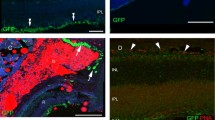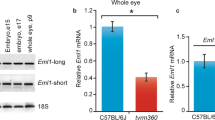Abstract
The product of the proto-oncogene p56lck is a non-receptor tyrosine kinase member of the Src family. It is found in T cells (Marth et al., 1985, 1988) and in the mouse brain (Omri et al., 1996; Van Tan et al., 1996). In this report, we describe experiments showing that Lck is present in the mouse retina neurons. Lck gene expression was identified after isolating and sequencing the specific 5' and 3' part of the cDNA obtained by RT – PCR. In adult retina Lck immunoreactivity was most abundant in photoreceptor cells and within the outer plexiform layers. Staining was also observed in the inner nuclear and plexiform layers. In transgenic mice, the disruption of the Lck gene had serious consequences on the organization of the retina causing retinal dysplasia. These mice have partial retinal detachment with infolding and rosette formation in the photoreceptor sheet. These retinal abnormalities observed in Lck deficient mice lead to the loss of normal architecture of the photoreceptor and the inner nuclear layers, and provide an important role of Lck protein in the retina development. The lack of the Lck protein produces a spectrum of retinal pathology that resembles human retinopathy of prematurity (ROP).
Similar content being viewed by others
Author information
Authors and Affiliations
Rights and permissions
About this article
Cite this article
Omri, B., Blancher, C., Neron, B. et al. Retinal dysplasia in mice lacking p56lck. Oncogene 16, 2351–2356 (1998). https://doi.org/10.1038/sj.onc.1201761
Received:
Revised:
Accepted:
Published:
Issue Date:
DOI: https://doi.org/10.1038/sj.onc.1201761
- Springer Nature Limited




